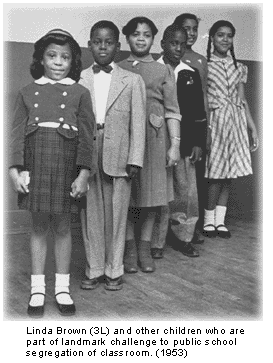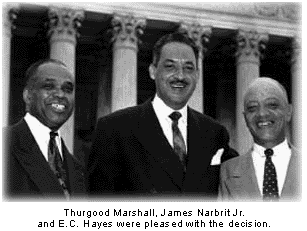On May 17, 1954, in a case argued by NAACP attorney Thurgood Marshall, the Supreme Court ruled in a unanimous decision that the "separate but equal" doctrine was unconstitutional because it violated Fourteenth Amendment rights by separating students solely on the classification of the color of their skin.
Chief Justice Warren delivered the court's opinion, stating that "segregated schools are not equal and cannot be made equal, and hence they are deprived of the equal protection of the laws." This ruling in favor of integration was one of the most significant strides America has taken in favor of civil liberties.
Background
The supreme court case Plessy v. Ferguson is one of the most somber chapters in the pages of American civil rights history. In this landmark decision of 1896, the court found that the doctrine of "separate but equal" concerning segregation of public facilities did not violate the Constitution. Separate schools for whites and blacks became a basic rule in Southern society, legitimized by this doctrine that legalized segregation.
 In the Midwest town of Topeka, Kansas, a little girl named Linda Brown had to ride the bus five miles to school each day, although a public school was located only four blocks from her house. The school was not full and the little girl met all of the requirements to attend, all but one, that is. Linda Brown was black. And blacks were not allowed to go to white children's schools.
In the Midwest town of Topeka, Kansas, a little girl named Linda Brown had to ride the bus five miles to school each day, although a public school was located only four blocks from her house. The school was not full and the little girl met all of the requirements to attend, all but one, that is. Linda Brown was black. And blacks were not allowed to go to white children's schools.
It was not until 1954 that the doctrine of "separate but equal" was challenged. In an attempt to gain equal educational opportunities for their children that were not provided for under the Plessy vs. Fergusen decision, African-American community leaders took action against segregation in America's schools. Aided by the local chapter of the NAACP, a group of 13 parents filed a class action suit against the Board of Education of Topeka Schools.
Organized resistance to integration
The change against segregated schools did not come without a fight. Southern activists and politicians resisted the move and did much to stop integration from invading their states. In 1957, President Dwight D. Eisenhower was forced to send National Guard troops to the Little Rock, Arkansas, High School to protect the first entering black students. Numerous white parents reacted by moving their children to private schools.
Forced busing
By 1968, the continued crawling pace of integration was frustrating the federal courts. In New Kent County, Virginia, most black students voluntarily chose to attend the George W. Watkins School instead of New Kent High School. However, Calvin Green, a black parent, sued the county school system to force a radical desegregation scheme. In its decision, the U.S. Supreme Court laid the groundwork for busing plans that caused controversy in Virginia and across the nation.
Inadvertent and unintentional segregation
Lacking the southern tradition of segregation, black migration to the West Coast before and during World War II had increased, owing to such large government construction projects as bridge, dam, harbor and shipbuilding jobs available there during The Great Depression, and in support of the World War II effort.
Severe prewar labor union strikes on the San Francisco docks almost destroyed the San Francisco shipping industry (which moved to Oakland, Long Beach and Seattle ports), and the end of World War II severely reduced available jobs in the San Francisco Bay Area and other West Coast cities.
Due to increased competition for jobs after World War II, employment available to blacks became even more limited, thus driving more black communities toward poverty. Increased postwar black migration to West Coast cities only exacerbated poor employment and educational opportunities for blacks there.
Concurrently, the GI Bill offered new opportunities to America's war veterans. Low interest loans for higher education and new suburban homes, along with the more affordable automobile and newly built highways created a flight from America's cities (by mostly whites) to the new suburbs, complete with new schools, (mostly white), for the Baby Boom Generation.
The traditional urban tax base supporting most American cities quickly began to dissolve, inadvertently undermining financial support for urban public schools and traditional urban public services, further exacerbating poverty and segregation nationwide.
Affirmative Action
Marking the beginning of the modern American Civil Rights Movement, the 1954 landmark Brown vs. Board of Education decision by the Supreme Court altered the economic, political and social structure of America and forced social change in America forever. As a result of the original Brown case, all American public schools became formally, albeit reluctantly, integrated. Americans at the local and personal level were not buying into forced integration.
 Frustrated by the slow pace of school, employment, and housing integration, the NAACP, ACLU, Women's Liberation Movement and other activist groups successfully got behind the concept of Affirmative Action during the 1970s.
Frustrated by the slow pace of school, employment, and housing integration, the NAACP, ACLU, Women's Liberation Movement and other activist groups successfully got behind the concept of Affirmative Action during the 1970s.
Upon winning the presidency with a conservative mandate in 1980, Ronald Reagan countered some of the Affirmative Action momentum by declaring that it was "reverse discrimination" and bad for the economy. Nevertheless, the school integration laws stand as milestones in civil rights.